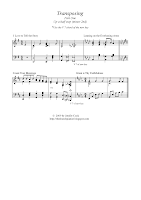Today's article will introduce this popular chord...
the V 7 of the new key (the key you want to
transpose to).
For instance, say... I want to go from G Major to A flat
Major (a half step higher).
Well...the V 7 chord in the key of A flat Major is
E flat. ( You always have to think ahead to the new key
to compute the V 7 chord).
The distance of keys between the two songs determines
what chords will sound best for the transposition.
You can always count on the V 7 chord of the new key
as a great link between the keys.
I'll begin by introducing two examples for transposing a
half step (minor 2nd) higher from the original key.
Editor notes for today's example:
*Songs with matching moods need no ritard for
ease of transistion.
* Songs with different moods require a ritard;
allowing time for a gear shift :)
*It does sound nice to lower the 7th tone of the original
key before moving into the V 7 chord of the new key.
I always lowered the 7th tone in the left hand for a nice
octave progression into the V 7 chord.
Audio of today's examples:
http://www.box.net/shared/8xce5tcr2b
Click on the following link for more information
on transposing.
https://blogger.googleusercontent.com/img/b/R29vZ2xl/AVvXsEiSxdfSaPCto4kzlKzgXYDgUZOWLWkCMT3Ug2OMdwOT0idWp-eEnSAl4U4ziz0PrWm5f0fSI2jgV56cQDSN5-6pIHK-FqgSva9oeEZDhk_T4dGJoX0AC73g0Aa3HjKd7yw5uqOTFwIGufSv/s1600-h/-+%5BTransposing+up+a+whole+step.png
My new website: http://thechurchpianist.com/


No comments:
Post a Comment